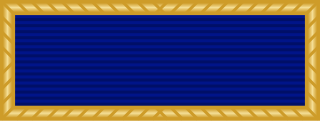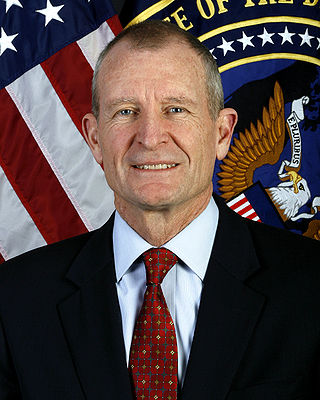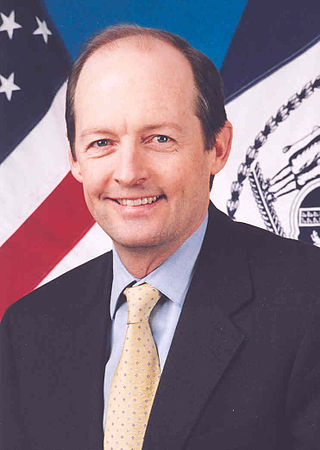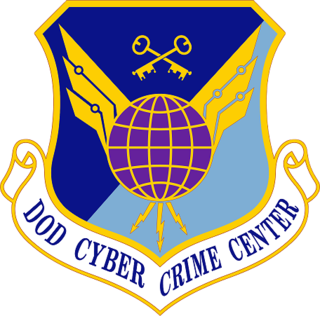Related Research Articles

The National Security Agency (NSA) is an intelligence agency of the United States Department of Defense, under the authority of the Director of National Intelligence (DNI). The NSA is responsible for global monitoring, collection, and processing of information and data for foreign intelligence and counterintelligence purposes, specializing in a discipline known as signals intelligence (SIGINT). The NSA is also tasked with the protection of U.S. communications networks and information systems. The NSA relies on a variety of measures to accomplish its mission, the majority of which are clandestine. The NSA has roughly 32,000 employees.

The United States National Security Council (NSC) is the principal forum used by the president of the United States for consideration of national security, military, and foreign policy matters. Based in the White House, it is part of the Executive Office of the President of the United States, and composed of senior national security advisors and Cabinet officials.

DynCorp, formally DynCorp International, was an American private military contractor. Started as an aviation company, the company also provided flight operations support, training and mentoring, international development, intelligence training and support, contingency operations, security, and operations and maintenance of land vehicles. DynCorp received more than 96% of its more than $3 billion in annual revenue from the U.S. federal government. The corporate headquarters were in an unincorporated part of Fairfax County near Falls Church, Virginia, while the company's contracts were managed from its office at Alliance Airport in Fort Worth, Texas. DynCorp provided services for the U.S. military in several theaters, including Bolivia, Bosnia, Somalia, Angola, Haiti, Colombia, Kosovo and Kuwait. It also provided much of the security for Afghan president Hamid Karzai's presidential guard and trained much of the police forces of Iraq and Afghanistan. DynCorp was also hired to assist recovery in Louisiana and neighboring areas after Hurricane Katrina. The company held one contract on every round of competition since receiving the first Contract Field Teams contract in 1951.

The Walter Reed Army Medical Center (WRAMC), officially known as Walter Reed General Hospital (WRGH) until 1951, was the U.S. Army's flagship medical center from 1909 to 2011. Located on 113 acres (46 ha) in Washington, D.C., it served more than 150,000 active and retired personnel from all branches of the United States Armed Forces. The center was named after Walter Reed, a U.S. Army physician and sergeant who led the team that confirmed that yellow fever is transmitted by mosquitoes rather than direct physical contact.

The Situation Room is an intelligence management center on the ground floor of the West Wing of the White House. While the name suggests it is a single room, it is in fact a 5,000 square feet (460 m2) operations center attached to three secure conference rooms. It is run by about 130 National Security Council staff for the use of the president of the United States, chief of staff, national security advisor, homeland security advisor, and other senior advisors for monitoring and dealing with crises, as well as conducting secure communications with outside persons. The Situation Room has secure, advanced communications equipment for the president to maintain command and control of U.S. forces around the world.

Lowry Air Force Base is a former United States Army Air Forces (USAAF) training base during World War II and a United States Air Force (USAF) training base during the Cold War. From 1955-1958, it served as the initial site of the U.S. Air Force Academy. It is a U.S. Formerly Used Defense Site (B08CO0505).

The National Intelligence Distinguished Service Medal (NIDSM) is a decoration awarded for service to the United States Intelligence Community. The decoration is awarded to any member or contributor to the National Intelligence Community, either civilian or military, who distinguishes themselves by meritorious actions to the betterment of national security in the United States of America, through sustained and selfless service of the highest order.

The Presidential Unit Citation (PUC), originally called the Distinguished Unit Citation, is awarded to units of the uniformed services of the United States, and those of allied countries, for extraordinary heroism in action against an armed enemy on or after 7 December 1941. The unit must display such gallantry, determination, and esprit de corps in accomplishing its mission under extremely difficult and hazardous conditions so as to set it apart from and above other units participating in the same campaign.

Dennis Cutler Blair is the former United States Director of National Intelligence and a retired United States Navy admiral who was the commander of U.S. forces in the Pacific region. Blair was a career officer in the U.S. Navy and served in the White House during the presidencies of both Jimmy Carter and Ronald Reagan. Blair retired from the Navy in 2002 as an Admiral. In 2009, Blair was selected as President Barack Obama’s first Director of National Intelligence, but after a series of bureaucratic battles, he resigned on May 20, 2010.

Coast Guard Intelligence (CGI) is the military intelligence branch of the United States Coast Guard, and a component of the Central Security Service of the United States Department of Defense.

The National Intelligence Coordinating Agency (NICA) is the primary intelligence gathering and analysis arm of the Government of the Philippines in charge of carrying out overt, covert, and clandestine intelligence activities. The NICA directs, coordinates, and integrates all intelligence activities, both foreign and domestic, concerning national security, serving as the leading intelligence collector of the national government, focusing on the country's strategic intelligence requirements. It is mandated to prepare intelligence estimate on local and foreign situation for the formulation of national security policies by the President and the National Security Council.
The Seton Hall reports, also known as the Denbeaux studies, are several studies published by the Center for Policy and Research at Seton Hall University Law School in the United States beginning in 2006, about the detainees and United States government policy related to operations at the Guantánamo Bay detention camp. At a time when the government revealed little about these operations, the reports were based on analysis of data maintained and released by the Department of Defense. The director of the Law School's Center, Mark P. Denbeaux, supervised law student teams in their analysis and writing the studies. The first study was Report on Guantanamo Detainees: A Profile of 517 Detainees through Analysis of Department of Defense Data.
The Agence Nationale de Renseignements (ANR) is a government intelligence agency of the Democratic Republic of the Congo (DRC). The role of the agency is to ensure "internal security and external security" of the state. The agency was strongly criticized for the disrespect of human rights by several organisations. Inzun Kakiak has led the agency since 2019.
Intelligence Analysis Management is the process of managing and organizing the analytical processing of raw intelligence information. The terms "analysis", "production", and "processing" denote the organization and evaluation of raw information used in a phase informally called "connecting the dots", thus creating an "intelligence mosaic". The information may result in multiple analytic products, each with different security classifications, time scales, and levels of detail. Intelligence analysis goes back to the beginning of history. Sherman Kent is often considered the father of modern intelligence analysis. His writings include a 1947 book, Strategic Intelligence for American World Policy.

Michael A. Sheehan was an American author and former government official and military officer. He was a Distinguished Chair at the U.S. Military Academy in West Point, New York and a terrorist analyst for NBC News.
The Project on National Security Reform (PNSR) was a nonpartisan non-profit organization mandated by the United States Congress to recommend improvements to the U.S. national security system. Advocates of reform of the U.S. national security system contend that the fundamental components of the system, which includes the National Security Council, the Department of Defense, the Department of State, the Central Intelligence Agency, among others, were largely designed via the National Security Act of 1947 in order to combat the Soviet Union. Today's global security environment, largely due to globalization, is much more complex than it was during the Cold War. PNSR argues that government structures need to be more agile and efficient in order to combat new threats such as terrorism, transnational crime, and rogue states.

The Department of Defense Cyber Crime Center (DC3) is designated as a Federal Cyber Center by National Security Presidential Directive 54/Homeland Security Presidential Directive 23, as a Department of Defense (DoD) Center Of Excellence for Digital and Multimedia (D/MM) forensics by DoD Directive 5505.13E, and serves as the operational focal point for the Defense Industrial Base (DIB) Cybersecurity program. DC3 operates as a Field Operating Agency (FOA) under the Inspector General of the Department of the Air Force.

Battle command (BC) is the discipline of visualizing, describing, directing, and leading forces in operations against a hostile, thinking, and adaptive enemy. Battle command applies leadership to translate decision into actions, by synchronizing forces and warfighting functions in time, space, and purpose, to accomplish missions. Battle command refers both to processes triggered by commanders and executed by soldiers and to the system of systems (SoS) that directly enables those processes.

Camp Withycombe, located in Clackamas County, Oregon, United States, was originally established as Camp Benson after Governor Frank W. Benson, but was later renamed Camp Withycombe during World War I for Governor James Withycombe.

The United States Space Force (USSF) is the space service branch of the United States Armed Forces. Along with the Air Force, it is part of the Department of the Air Force, led by the secretary of the Air Force. Its military heads are the chief of space operations, who is one of the Joint Chiefs of Staff, and the vice chief of space operations.
References
- ↑ "Intelligence inside the White House: The influence of executive style and technology", David A. Radi, March, 1997, Center for Information Policy Research Archived 2007-02-25 at the Wayback Machine , Harvard University "Archived copy" (PDF). Archived from the original on 2007-02-25. Retrieved 2018-02-14.
{{cite web}}: CS1 maint: archived copy as title (link) CS1 maint: bot: original URL status unknown (link) - ↑ Indications, Warnings and Crisis Operations", Thomas G. Belden, International Studies Quarterly, v. 21 n. 1, March, 1977, pp. 181-198